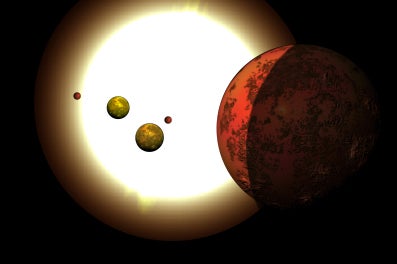An undergraduate student working on Kepler planets turned up something extraordinary: a planetary system with a rare orbital configuration.
In a study, soon to be published in the Astronomical Journal, led by Mariah MacDonald, an undergraduate student at Florida Institute of Technology (FIT), found that all five of Kepler-80’s planets orbited within 0.1 astronomical unit (AU) from the star. This is a distance of about one-third the distance between our Sun and Mercury. These planets all orbit in such a way that they return to the same position in the solar system every 27 days.
It is thought that 10-50 percent of all alien solar systems that have planets fall into the category known as Systems with Tightly-spaces Inner Planets (STIPs). These are systems where a star’s planets are all very close in orbit to the parent star. Not only is the Kepler-80 system a STIP, but its planets weave through a series of resonances.
Kepler-80, named after the Kepler telescope who found the system, is located about 1,100 light-years away where all five planets have extremely short orbits, with “years” of approximately one, three, four, seven, and nine Earth days. With the planet’s close proximity to the star, Kepler was able to detect small dips in light (about 0.001 percent) from their transits between the star and Kepler.
Through analysis, MacDonald and collaborators were able to reveal that the masses of the outer four planets range from four to six times that of Earth. It is thought that these systems with tightly packed planets formed out farther from the star then migrated in and settled into their current orbits.
“For Kepler-80 and other STIPs, many of the planets are too close in to have formed there, so they must have migrated in,” says MacDonald. “This is where the orbit loses energy and essentially shrinks closer in to the star.”
The four outer planets have “synchronized” orbits, another rarity. The planets possess multiple three-body resonances, which return to the same configuration every 27 days which help in stabilizing the orbits. The most notable three-body resonance are the three Galilean moons of Io, Europa, and Ganymede.
“To put this to numbers, over 800 systems have been confirmed to host planets,” says MacDonald. “A handful of systems have their planets in a three body resonance, only one thus far has two three body resonances, none have three, and Kepler 80 is the only one with four.”
In this resonance, the first three planets would be in resonance with each other; the last three planets are in this same resonance with each other, as are the first two planets and last planet would be in resonance; and the first planet and last two planets in resonance. (Hopefully we didn’t lose you here.) This comprises the four full resonances found with three planets in each pattern.
As for MacDonald, her work is done with Kepler-80 as she is going to Pennsylvania State University for her graduate degree, but her and her collaborators left very well documented findings to encourage others to continue work on this system.
MacDonald says, “at the end of our paper, we included a table of future transit times for the four outer planets to encourage someone else to observe the system more and unlock more exciting discoveries.”










